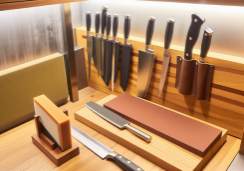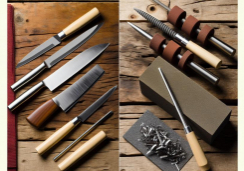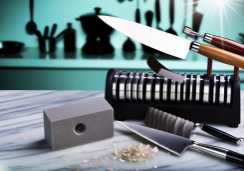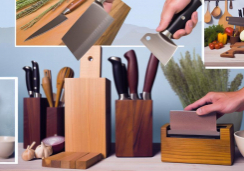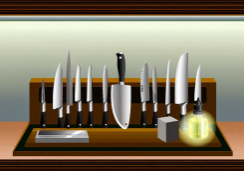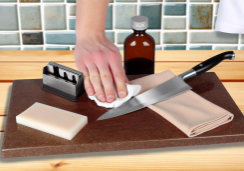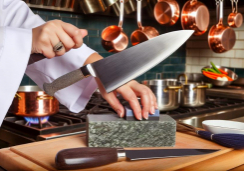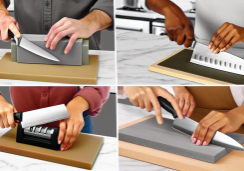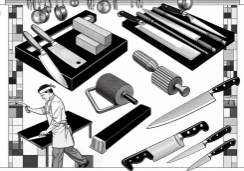Top 4 Chef Knife Sharpening Methods Explained
You know that a chef's knife can become as dull as a weekday afternoon without the right sharpening technique, rendering even the simplest of slicing tasks a chore. Whether you're a professional chef or a home cook, maintaining that razor-sharp edge is crucial for efficiency and safety in the kitchen.
You've likely encountered the classic whetstone, the ubiquitous honing steel, the convenient electric sharpener, and the option of enlisting professional services, but understanding the nuances of each method could mean the difference between a mediocre tool and a masterful blade.
As you stand at the precipice of culinary excellence, let's explore the strengths and weaknesses of these top sharpening contenders, and why choosing the right one could elevate your cooking experience to unprecedented heights.
Whetstone Sharpening Essentials
To achieve a razor-sharp edge on your chef knife, it's essential to master the use of a whetstone, a tool favored by culinary professionals for its precision and control. Begin by selecting the appropriate grit size. Whetstones range from coarse, which quickly reshapes the edge, to ultra-fine, for polishing and finishing. A medium-grit whetstone, typically around 1000 grit, is a versatile starting point for routine sharpening.
Before you start, soak the stone according to the manufacturer's instructions—usually until bubbles cease to rise. Secure the stone on a non-slip base to maintain stability during sharpening. Hold the knife at a consistent angle, generally between 15 to 20 degrees, applying even pressure as you glide the blade across the whetstone in smooth, controlled strokes. Alternate between sides to ensure an evenly honed edge.
Remember to maintain the whetstone's surface; it must be flat for effective sharpening. You'll need to periodically re-flatten the stone with a lapping plate or flattening stone.
With patience and practice, you'll be able to keep your chef knife in peak condition, ensuring precise cuts and a longer lifespan for your valued tool.
Honing Steel Technique
While a whetstone is critical for sharpening your chef knife, regular use of a honing steel will maintain the blade's edge between sharpenings. The honing steel doesn't actually sharpen the blade; it realigns the edge of the knife, correcting the microscopic bends and nicks that occur with routine use.
Here's how you'll do it: hold the honing steel vertically with the tip firmly planted on a non-slip surface. With your knife in the other hand, place the heel of the blade against the top of the steel at approximately a 15 to 20-degree angle. This angle is crucial; it matches the cutting edge of most chef knives.
Now, apply gentle pressure as you glide the knife down the steel, pulling the knife towards you while simultaneously moving it so the middle and then the tip of the blade makes contact with the steel. Repeat this motion 5 to 10 times on one side before switching to the other side of the blade.
Consistency is key. You'll want to maintain the angle and pressure with each stroke. With practice, honing will become a quick and effortless part of your knife maintenance routine, ensuring a consistently sharp edge for precision cutting.
Electric Sharpener Use
For those seeking a quick and precise edge, electric sharpeners offer a convenient solution for maintaining your chef knife. These devices generally feature one or more slots with built-in abrasive wheels that spin rapidly to remove metal from the blade, honing it to a fine edge. It's critical that you select an electric sharpener that's appropriate for the angle of your chef knife—usually between 15 to 20 degrees.
When you're ready to sharpen, ensure the sharpener is stable on your countertop to prevent any slippage. Start with the coarsest slot if your knife is particularly dull or damaged. Gently pull the knife through the slot, applying consistent pressure; avoid pressing down too hard, as this can damage the blade. After a few passes, switch to the finer grinding slot to polish and refine the edge.
Always keep the blade wet during the sharpening process to minimize overheating, which can lead to a loss of temper in the steel. Once sharpened, test the knife on a piece of paper or a tomato to check for the desired sharpness. Regular maintenance with an electric sharpener can significantly extend the life and performance of your chef knife.
Professional Sharpening Services
If you're seeking the utmost precision and a professionally honed edge, consider enlisting the services of a professional sharpening service, which utilizes expert techniques and specialized equipment to sharpen your chef knife meticulously.
These services employ seasoned artisans who are well-versed in the intricacies of knife geometry and edge angles, ensuring that your blade is restored to its optimal sharpness without compromising its integrity.
Professional sharpeners often use a combination of water-cooled grinding wheels, fine-grit whetstones, and honing rods to achieve a razor-sharp edge. They follow a systematic process that begins with assessing your knife's condition, followed by careful grinding to remove any nicks or dullness. Subsequently, they refine the edge with successive stages of honing, employing stones of increasingly finer grit to polish the blade and eliminate any burrs.
The advantage of using a professional service is their ability to tailor the sharpening to your knife's specific steel type and intended use, whether it's for delicate slicing or heavy chopping. They can also re-profile a knife to correct any blade misalignment, ensuring a symmetrical edge.
Trusting a professional with your chef knife guarantees a sharpness that enhances cutting efficiency and maintains the longevity of your culinary tool.
Are the Chef Knife Sharpening Methods Applicable to Handmade Kitchen Knives as Well?
Yes, the best handmade kitchen knife techniques for sharpening chef knives can also be applied to handmade kitchen knives. The key is to use the correct angle and pressure to achieve a sharp edge without compromising the blade. Proper technique is crucial for maintaining the sharpness of all knives.
Conclusion
You've now mastered the top chef knife sharpening methods. Whether you're honing with a whetstone, maintaining the edge with a honing steel, utilizing the convenience of an electric sharpener, or opting for professional services, your blades will remain impeccably sharp.
Remember, precise technique is paramount in each method to ensure optimal performance of your knives. Maintain your tools with care, and they'll contribute to the excellence of your culinary creations.

